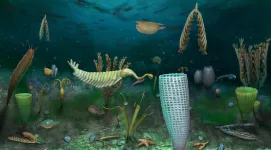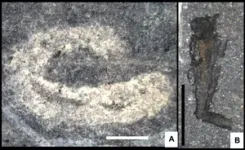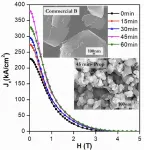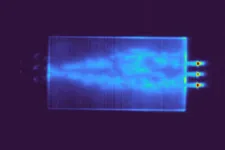(Press-News.org) An unusually well-preserved "Marine Dwarf World" from 462 million years ago was found at Castle Bank, Wales by a team led by the Nanjing Institute of Geology and Palaeontology of the Chinese Academy of Sciences (NIGPAS). The site comprises over 150 species, with many of miniaturized body size. It is one of the world's most unexpected fossil sites.
The study was published in Nature Ecology & Evolution on May 1.
Castle Bank, in Powys, is one of the very rare sites where soft tissue and complete organisms are preserved, providing an unrivaled view of the evolution of life. Among the best of these sites are Burgess Shale-type faunas, named after the classic Burgess Shale fossil-bearing deposit in Canada.
Many of these sites occur in rocks from the Cambrian period (542–485 million years ago), when recognizable animal fossils first appeared. However, almost none occur in post-Cambrian rocks. As a result, paleontologists know a lot about Cambrian marine life, but less about how it evolved in the periods immediately afterwards.
Castle Bank is from the middle of the succeeding Ordovician Period, some 462 million years ago, and rivals the best of the Cambrian deposits in diversity of fossils and extraordinary levels of preservation.
The remarkable new assemblage was discovered in 2020 by Dr. Joe Botting and Dr. Lucy Muir, two authors of this study, near Llandrindod, central Wales.
So far, well over 150 species have been recovered, almost all of them new. Many of the animals are very small, at only 1–3 mm long, but they preserve minute details. They range from arthropods like crustaceans and horseshoe crabs to various types of worms, sponges, starfish, and many, many more. In some animals, internal organs such as digestive systems and even nerves are preserved, together with the limbs of tiny arthropods and delicate filter-feeding tentacles. Such exquisite detail is known from the best Cambrian faunas, but not previously from the Ordovician.
The Castle Bank fauna represents a community of diverse marine organisms from the Middle Ordovician, and many of the shelly fossils were normal for these rocks.
In addition, the range of fossils also includes several unusual discoveries, from unexpectedly late examples of Cambrian animals looking like opabiniids (weird proto-arthropods with a long proboscis) and wiwaxiids (slug-like molluscs armored with scales), to tantalizing, unexpectedly early fossils that resemble modern goose barnacles, cephalocarid shrimps (which have no fossil record at all) and possibly even a marine relative of insects.
The Cambrian witnessed the origin of the major animal groups. The Ordovician was a critical time in the history of life as well, with an extraordinary diversification of animals that produced hard skeletons and abundant fossils. In addition, more familiar ecosystems like today's coral reefs appeared by the end of the Ordovician. Until now, however, a big "gap" has existed between these two evolutionary events.
A new Burgess Shale-type fauna from the middle of this interval will help close this gap by answering questions about the animal shift from Cambrian fauna to Palaeozoic fauna and about the shift in ecosystems from the Cambrian style (which were similar across much of the world) to the much more diversified ecology we see today.
A few papers describing sponges and one on a primitive relative of modern arthropods called Mieridduryn have been published based on this fauna. Many more papers will follow and collections are ongoing. According to Dr. Muir, "Most fossil deposits of this importance are studied for many decades, and this is likely to be no different!"
Joseph Botting and two collaborators from NIGPAS (Y. D. Zhang, and J. Y. Ma) have been collaborating on the Konservat-Lagerstätte of Ordovician, and parts of this work, including the observation and analysis of some specimen and reconstruction, are completed in NIGPAS under the support of CAS.
The Castle Bank fauna has important implications for the evolution of sponges, especially Hexactinellida, and is considered as transitional interval between sponges of Cambrian and those of Anji fauna, another Burgess-Shale type fauna from Zhejiang, China, which the researchers have been devoting themselves to for years.
END
Middle Ordovician “marine dwarf world” found from Castle Bank, Wales (UK)
2023-05-01
ELSE PRESS RELEASES FROM THIS DATE:
Florida Inventors Hall of Fame announces 2023 inductees
2023-05-01
TAMPA, Fla. (May 1, 2023) – Ten Florida inventors inducted into the Florida Inventors Hall of Fame demonstrate that a personal drive to improve the human condition is a powerful force for transformation. Among them are Jonathan Rothberg, who pioneered the next-generation of human DNA sequencing, enabling low-cost decoding of human and other living organisms’ genomes; and Daniel Joseph, whose advances in special effects and illusion at Disney Imagineering have revolutionized the theme park experience ...
Assessing the impact of going off-grid on transmission charge and energy market outcomes
2023-05-01
Efforts to combat climate change have contributed to the rise of renewable energy production through solar panels, windmills, and other technologies. Because of this, consumers have now become “prosumers,” capable of producing their own electricity. While the prosumers’ use of distributed renewable energy increases the energy sector’s resilience, their decreased reliance on the bulk electricity market has led to new and unintended consequences.
It is anticipated that these avenues will push traditional consumers to become prosumers, making it difficult to recover lumpsum infrastructure investments ...
Towards a sustainable superconductor technology with magnesium diboride super magnets
2023-05-01
Magnesium diboride (MgB2), a binary compound, behaves as a superconductor – a substance that offers no resistance to electric current flowing through it – at a moderate temperature of around 39 K (-234°C). This temperature can be achieved using relatively inexpensive liquid hydrogen or neon coolants. In addition, MgB2 is inexpensive, lightweight, and non-toxic, and its precursors – magnesium (Mg) and boron (B) – are abundantly available. As a result, it can replace conventional low-temperature ...
Steve Landers M.D., MPH named next President & Chief Executive Officer of Hebrew SeniorLife
2023-05-01
Boston, MA - Hebrew SeniorLife, a Harvard Medical School-affiliated, integrated system of health care, senior living, research, and teaching that serves more than 3,000 Greater Boston seniors each day, announces the appointment of Steve Landers M.D., MPH as its new president & chief executive officer.
Dr. Landers comes to Hebrew SeniorLife from Visiting Nurse Association (VNA) Health Group, Inc., one of the oldest, largest, and most respected home health, hospice, and community health organizations in the country, where he has served since 2012 as president and chief executive officer. He is a practicing physician, certified in family medicine, geriatric medicine, and ...
Mass General Brigham expert calls for reforms to address the overdose crisis
2023-05-01
At the end of 2022, the federal government eliminated the “X waiver,” a major hurdle to providing addiction treatment, but progress needs to be continued, according to the authors of a new Perspective piece published in the New England Journal of Medicine. The X waiver required a special license and uncompensated training for physicians and other prescribers, creating a regulatory barrier to offering lifesaving buprenorphine treatment for opioid use disorder. Ending the X, the authors write, is necessary but not sufficient to achieve overdose-prevention goals.
Sarah Wakeman, MD, Medical Director for Substance Use Disorder at Mass General Brigham, and her co-author ...
New metric allows researchers to better understand soft material behavior
2023-05-01
CHAMPAIGN, Ill. — The mechanics behind the collapse of soft materials structure have befuddled researchers for decades. In a new study, researchers uncover a metric that finally correlates microscopic-level processes with what is seen at the macroscopic level.
The new metric is poised to help bring advances to various materials engineering challenges – ranging from the formulation of better 3D printing inks, the construction of wearable flexible electronics and sensors, the accurate printing of biomedical implants, to helping control landslides and avalanches, and ...
Boston University Chobanian & Avedisian School of Medicine names Educators of the Year
2023-05-01
(Boston)–Five Boston University Chobanian & Avedisian School of Medicine faculty have been honored as 2023 Educators of the Year by the School’s Awards Committee. Nominated by students and faculty, the annual awards recognize School of Medicine educators who provide excellence in teaching and mentoring.
This year’s recipients are Ricardo Cruz, MD, MPH, Educator of the Year, Preclerkship; Julia Bartolomeo, MD, Educator of the Year, Clerkship; Lillian Sosa, MS, CGC, Educator of the Year in MA/MS Programs; Douglas Rosene, PhD, ...
BU researcher receives prestigious Fulbright Scholar Award
2023-05-01
(Boston)—Sean D. Tallman, PhD, RPA, assistant professor of anatomy & neurobiology at Boston University Chobanian & Avedisian School of Medicine, has been awarded a Fulbright Scholar Award. This award allows U.S. academics to engage in multi-country, trans-regional projects.
Tallman will travel to South Africa for 10 months to conduct human skeletal biology research for his project, "Assessing the Effects of Disadvantage and Ancestry in Skeletal Health and Forensic Medicine" at the University of Cape Town and Stellenbosch University.
Tallman ...
Lithography-free photonic chip offers speed and accuracy for artificial intelligence
2023-05-01
Photonic chips have revolutionized data-heavy technologies. On their own or in concert with traditional electronic circuits, these laser-powered devices send and process information at the speed of light, making them a promising solution for artificial intelligence’s data-hungry applications.
In addition to their incomparable speed, photonic circuits use significantly less energy than electronic ones. Electrons move relatively slowly through hardware, colliding with other particles and generating heat, while photons flow without losing energy, ...
Another pharmacological approach fails to diminish delirium severity or duration
2023-05-01
INDIANAPOLIS – A new study conducted by researchers from Regenstrief Institute and the universities of South Carolina and Indiana has found that the most commonly prescribed blood pressure medications, taken for at least six months prior to an intensive care unit (ICU) admission, did not protect against developing delirium in the ICU, regardless of patient age, gender, race, co-morbidities or insurance status.
Delirium, an acute brain failure, affects approximately seven million hospitalized patients in the U.S. annually and is associated with longer hospital and ICU length of stay, higher likelihood ...






